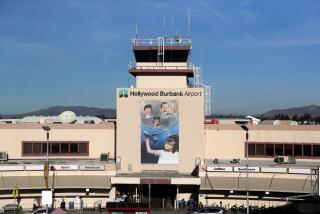Argument Doesn’t Fly
- Share via
Did Burbank and Glendale pull one over on their neighbors to the west when they reached an agreement to build a new Burbank Airport terminal that bans easterly takeoffs?
Probably.
Would lifting the ban distribute aircraft noise more equitably?
Probably not.
In 1986 the Federal Aviation Administration barred easterly takeoffs from Burbank Airport because the runway used was too close to the terminal building.
A draft agreement negotiated by the city of Burbank and the Burbank-Glendale-Pasadena Airport Authority would build a new terminal at a safe distance from both runways. So Reps. Howard L. Berman (D-Mission Hills), Brad Sherman (D-Sherman Oaks) and Henry A. Waxman (D-Los Angeles) shot off a letter to the FAA last week arguing that the ban should no longer be needed--except to protect homeowners in Glendale and parts of Burbank from the noise now suffered by the congressmen’s constituents in Valley Village, North Hollywood, Studio City and other neighborhoods south and west of the airport.
The congressmen’s argument may make sense, technically. But it’s not likely to have any practical effect on noise. And it’s certainly not cause for the FAA to reject the hard-won agreement, as the congressmen have asked.
Making Glendale and Burbank share more of the noise sounds fair, if noise were the only, or even the primary, concern. But it’s not. Safety comes first. And there are other reasons besides the present terminal’s proximity to the runway that make easterly takeoffs less safe.
Like the terminal up for replacement, the east-west runway was built in 1930 to accommodate smaller, lighter planes than those used today. It is shorter than the other runway and tilts uphill, yet requires today’s heavy planes to climb rapidly over the Verdugo Mountains. Prevailing winds are from the west; standard practice is to take off into the wind to give the airplane greater lift. Plus, easterly takeoffs put planes into airspace dominated by the Los Angeles International Airport, upsetting the delicate balance in the busy skies overhead.
Such conditions don’t give pilots much room to maneuver in an emergency, such as an engine failure. As Jon Russell, regional safety chairman with the Air Line Pilots Assn., put it, “You have a mountain staring you in the face, not to mention you are forced to turn into airspace that is among the busiest in the world.”
Who needs a ban? Common sense alone would dictate taking off in a direction with more of a safety margin. But because common sense, and safety, should dictate such a decision, planes would not likely take off to the east even if the ban were lifted.
With or without the ban, the terminal needs to be moved. It’s 313 feet from the center line of the east-west runway and about 340 feet from the other runway. The FAA recommends 750 feet.
The draft agreement not only puts the terminal in a safe location, it actually does something about noise. It phases out noisier older jets. It imposes a de facto curfew by closing the terminal at night.
The new terminal would have only 14 gates, the same number as the old terminal. Expansion would be limited and tied to further noise reductions.
Glendale and Burbank officials were no doubt pandering to their constituents when they included the ban in the agreement. But political posturing on the congressmen’s part is not going to get the terminal built any more safely, any more quickly--and any less noisily.
More to Read
Sign up for Essential California
The most important California stories and recommendations in your inbox every morning.
You may occasionally receive promotional content from the Los Angeles Times.













